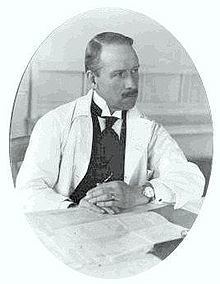Nationality Dutch Name Karel Wenckebach | Education Utrecht University Fields Anatomy, Cardiology | |
 | ||
Books Arhythmia of the Heart: A Physiological and Clinical Study Parents Eduard Wenckebach, Maria Geertruida Elisabeth Cornelissen | ||
Karel Frederik Wenckebach (March 24, 1864 – November 11, 1940) was a Dutch anatomist who was a native of the Hague.
Contents
He studied medicine in Utrecht, and in 1901 become a professor of medicine at the University of Groningen. Later he was a professor at the Universities of Strasbourg (1911–14) and Vienna (1914–29).
Contributions in cardiology
Wenckebach (pronounced ven-kĕ-bak') is primarily remembered for his work in cardiology. In 1899 he provided a description of irregular pulses due to partial blockage of atrioventricular conduction, creating a progressive lengthening of conduction time in cardiac tissue. The condition was referred to as a "second degree AV block" (Mobitz Type I), and later named the Wenckebach phenomenon. A similar phenomenon can also occur in the Sinoatrial node where it gives rise to Type I second degree SA block, and this is also known as a Wenckebach block; the two have distinct features on an ECG however.
Wenckebach is credited for describing the median bundle of the heart's conductive system that connects the sinoatrial node to the atrioventricular node. This bundle was named Wenckebach's bundle, and is also known as the middle internodal tract. Wenckebach's bundle is one of the three internodal pathways, the others being the "posterior internodal tract" (Thorel's pathway), and the "anterior internodal tract" (some fibers of which also project to Bachmann's bundle, and then into the left atrium).
Wenckebach was an early advocate involving the use of quinine for treatment of paroxysmal atrial fibrillation.
Family
His father Eduard (1813-1874) has been credited with developing the very first telegraphic communications line in the Netherlands, between Haarlem and Amsterdam. He had two brothers, Henri Johan Eduard (1861-1924), director of the State Mines and later of the Dutch Ironworks in IJmuiden, and Ludwig Willem Reymert (1860-1937), a well-known painter and book illustrator. His son Oswald became a sculptor, painter and medallist, most widely known for his war monuments and designing the Dutch coins issued between 1948 and 1981.
